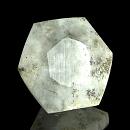|
|
|
|
Click on a letter above to view the list of gems. |
|
|
|
|
|
Hydroboracite |
|
| Chemistry: CaMgB6O8(OH)6∑3(H2O) [Hydrated Calcium Magnesium Borate] | |
| Discovered
in 1834;
IMA
status: Valid (pre-IMA; Grandfathered). | ||
|
| ||
|
Classification |
|
|
| |
|
Borates | |
|
5/J.03-20 | |
|
|
6 : BORATES |
|
Related to: |
Colemanite - Hydroboracite Series |
|
|
|
|
Crystal Data |
|
|
|
|
|
As slender crystals, prismatic along [001] and flattened on {010}, to 10 cm; in fanlike to radial spherical aggregates and in swallowtail composites; as drusy coatings; compact, fine-grained. |
|
|
None |
|
|
|
|
|
Physical Properties |
|
|
|
|
|
[010] Perfect, [100] Distinct |
|
|
Irregular/Uneven |
|
|
Brittle |
|
|
2.0 - 3.0; 5.0 - 6.0 in some specimens |
|
|
2.15 - 2.17 (g/cm3) |
|
|
None |
|
|
Not Radioactive |
|
|
Other: |
Virtually insoluble in cold water. Partially dissolved by prolonged submersion in boiling water. |
|
|
|
|
Optical Properties |
|
|
|
|
|
Colorless, White |
|
|
Transparent to Translucent |
|
|
Vitreous; Silky if fibrous |
|
|
1.520 - 1.571 Biaxial ( + ) |
|
|
0.0490 |
|
|
Relatively Weak; r < v |
|
|
None |
|
|
|
|
|
Occurances |
|
|
|
|
|
Geological Setting: |
Typically formed by groundwater alteration of Colemanite; may be primary. |
|
Common Associations: |
Colemanite, Tunellite, Ulexite |
|
Type Locality: |
Inder B deposit and salt dome, Atyrau (Gur'yev), Atyrau Oblysy (Atyrau Oblast'), Kazakhstan |
|
Year Discovered: |
1834 |
|
View mineral photos: | |
|
|
|
|
More Information |
|
|
|
|
|
| |
|
|
|
|
The
most notable occurances of Hydroboracite are: Kohnstein Quarry, Niedersachswerfen, Nordhausen, Harz
Mts, Thuringia, Germany; BigadiÁ Mine, BigadiÁ, Balikesir Province, Marmara
Region, Turkey; Boron Pit, U.S. Borax Mine, Boron, Kramer District, Kern
County, California, USA; and Death Valley, San Bernardino County, California, USA. |
|
|
We
have not photographed our Hydroboracite
gems. Please
check back soon. |
